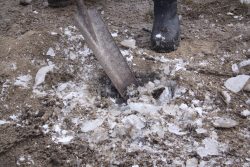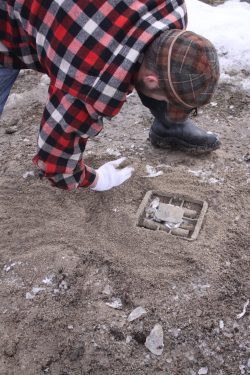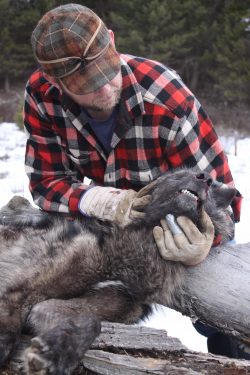Wolf trapping success requires a lot of things to go right. Traps must be dry and ready to work when the wolves step on the trap pan. This is not as easy as it sounds.
Rain, snow, frost and wind all play a major factor in whether or not traps will be ready to do their job at the very moment they need to or whether trappers add another story about a wolf track on a trap pan that didn’t fire. This happens way more than we trappers care to admit.
To keep traps working 24/7 takes diligence and wax, lots of wax. Recently it rained for four days then temperatures dropped and everything froze. These were the most challenging conditions but it was the day that wolf number five of the season filled my trapper quota for the season. So what does it take to keep them working?

A deep trap bed dug with enough room to accommodate chain, waxed dirt and a wolf trap is the foundation for success. When the set is finished the trap jaws should be about 1/4 to 1/2 inch below ground level.

Once the trap bed is dug add a half inch of waxed dirt then lay waxed paper over the dirt. Another layer of waxed dirt thick enough to push the trap into is important to keep the frost from seeping up under the trap and freezing it solid.
Now here is where trappers can make or break trapping success. Bed the trap solidly. Pack dirt around the jaws of the trap, under the jaws and make sure it doesn’t wiggle – at all. This is the number one reason for flipped, sprung and empty traps. Pound the dirt around the trap until there is no more compaction possible. Put crinkled up waxed paper under the trap or use a screen of the pan to keep an air space under the pan (otherwise it won’t fire) and cover the trap with waxed dirt.
An alternative to waxed dirt is coal slack which some trappers use instead. The point is that the dirt that is in the ground will freeze. Bedding traps in something that won’t freeze is absolutely necessary.

No matter how great the set location, lure, bait or scents are – if the trap doesn’t work when your trophy wolf steps on it the whole set is no good. Focus on the details of trap bedding to ensure that your trapping story doesn’t sound like “the one that got away” – but instead ends in a trophy photo.